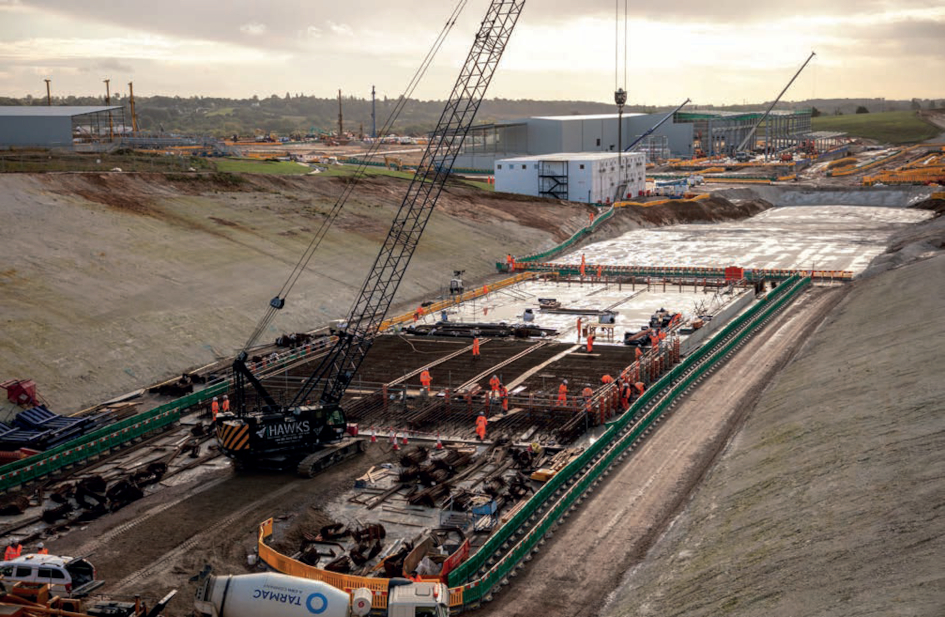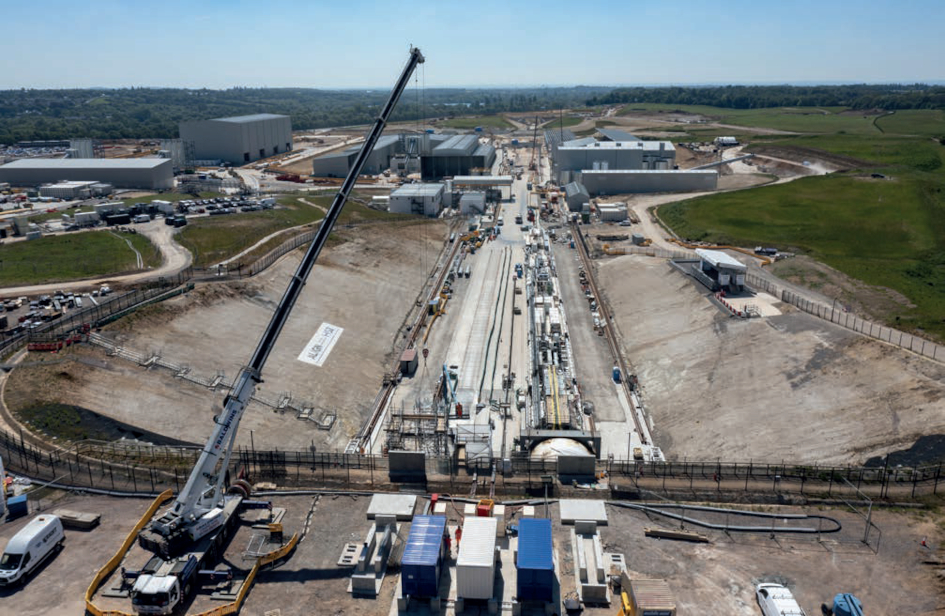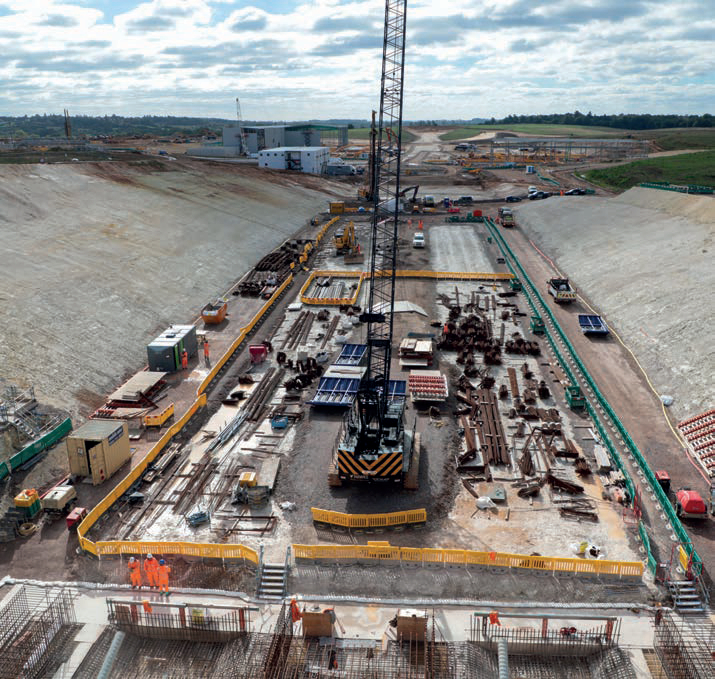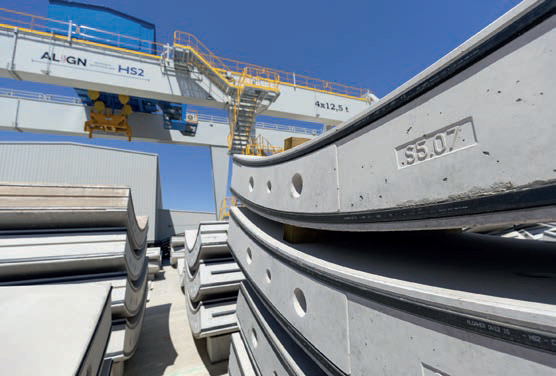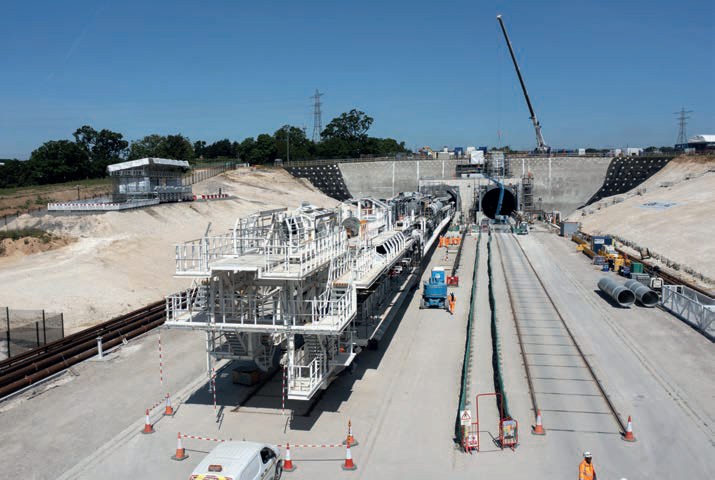Trains and cranes
27 July 2021HS2, Britain's new high-speed rail link, is a huge infrastructure project that demands cranes of every kind and size. Julian Champkin reports.
HS2 is the biggest infrastructure project in Europe. It is intended to speed communications between London and Birmingham and the north of England. Its first phase involves 140 miles (225km) of new rail line, 40 miles of which will be in tunnels.
Four major new stations and two new depots will be built. In addition, new platforms will be built at Euston Station; a new rail viaduct, the longest in the UK at 3.4km long, will carry the line out of London. A major new interchange will be built at Old Oak Common, on the outskirts of London, where existing lines from the west of England cross the new route. Latest cost estimates, as of June 2021, range up to ?98bn.
All of this tunnelling, station and line works will obviously require a large number of lifting equipment, of all kinds and capacities. Several joint ventures are involved, and contractors hoping for a slice of that business will need to buy or hire cranes of all types.
Preparatory work has already furnished examples. Tower cranes and mobile crawlers from demolition specialists McGee and John F. Hunt have helped demolish 1960s-era office blocks and warehouses near Euston to make room for the new tunnels into that station. Perhaps ironically, the first major change visible to the public has not been the erection but the removal of cranes. Three huge disused yellow container cranes at Willesden in west London have been removed to make way for a logistics hub to support the construction of the new line’s London tunnels. The 22m-high gantry cranes, each weighing up to 290t, have been familiar landmarks to rail passengers travelling into Euston over the past 25 years.
Each one had to be lifted and moved up to a hundred metres so they could be safely dismantled away from the neighbouring rail track, in what HS2 Ltd says was one of the most complex engineering challenges the project has faced so far. In 2018, A Costain Skanska joint venture, working with John F Hunt Limited and ALE Heavy Lift (now acquired by Mammoet) used a mobile crane supplied by Sarens to move the first two cranes.
The third, and heaviest, of the cranes was moved by the same team over live railway lines using SPMTs running on slabs specially prepared by engineering consultants Adun. Once safely away from the rail lines the crane was brought down in a controlled collapse.
The longest tunnel on the new route is the Chiltern tunnel, which from a portal alongside the M25 north-west of London will pass under that motorway and continue for 16km to emerge near Great Missenden in Buckinghamshire.
In July 2020, a Kobelco CKE900G-2 crawler crane on hire from Dartford-based crane rental company Hawks, started working on the construction of the approximately 150m-long, 50m-wide TBM ‘launch pad’, next to what will eventually be the finished tunnel exit at Mantle's Wood, north of the village of Hyde Heath, Buckinghamshire. It was on a six-month rental contract, and during that time was used for “typical civils duties,” says Hawks’ managing director Elliot Hawkins. “Tasks included moving rebar for the launch pad, as well as pre-cast concrete elements, concrete delivery hoppers and small pieces of construction equipment.” It also had to move 636 ‘soil nails’, some up to 20m long, that are driven in to the 17m-high headwall to stabilise it.
The 135-acre (55ha) site is host not only to the TBMs themselves but also to the precasting plant that makes the curved concrete sections that line the tunnel. They are produced on-site to minimise transport costs and disruption. Two identical production plants have been erected at the site and will be in continuous production for around three years, until the tunnel is complete. They will be casting the sections and sending them up the tunnel to the TBM, which sets them into place behind it as it digs its way onwards at a rate of around 15m per day. Inside each plant robotically-operated double-bridge overhead cranes from GH move and stack the moulds and their contents; outside in the storage yard larger 4x12.5t gantry cranes, also from GH, stack the segments and load them onto multipurpose vehicles for transport up the tunnel.
Meanwhile, at Old Oak Common, the largest new interchange on phase one, three Kobelco CKE1350G-2 lattice boom crawlers have been at work together with a brand new CKE900G-3, all supplied directly to Balfour Beatty.
At the northern end of the new line, in Birmingham, preparatory works have involved lifting gear from the heaviest to the lightest. The first permanent element of the new line’s infrastructure has already been installed. It is a 65m bridge over the M42 motorway, which will form part of the major remodelling of the road network and connect existing roads to the new HS2 Interchange Station to be constructed nearby.
The prefabricated bridge was installed in August 2020 over a period of just two days. Specialist engineering contractor Expanded (part of Laing O’Rourke, which with J. Murphy & Sons forms the LMJV Joint Venture working on HS2) led the operation. The 2,750t bridge structure was carried along the motorway on SPMTs - a 448-wheel array of them. It took one hour and 45 minutes to move the bridge span 150m to its final position. Traditional construction methods would have needed several weeks of lane closures on both carriageways.
The bridge is the first of four that will be needed. Opportunities for contractors with suitable heavy lifting gear will therefore not be lacking. In June, lifting equipment rental company LGH invested in high capacity Hi- Force 520t hydraulic cylinders, which are primarily aimed at the bridge building and repair sector. HS2 work was a factor in the acquisition. “That was certainly part of our thinking,” says Phil Smith, head of asset management at LGH. “We have engaged with several joint ventures and subcontractors on the HS2 project, both in London and in the Midlands. These are low height, lock ring, single-acting cylinders, perfectly suited for the infrastructure sector which includes bridgeworks – and there are 135 over-bridges, 195 under-bridges and 70 viaducts, spanning 30km altogether, on the project. The cylinders can be used for both installation and maintenance of those new structures.”
“We foresee a higher demand for higher tonnage and specialised equipment for HS2,” he says. “We are already seeing a greater need for larger capacity spreader beams for such work; we are closely monitoring our fleet of specialised, bespoke beams and reviewing our availability.”
The new Curzon Street station which will serve HS2 in Birmingham demonstrates the need for lighter lifting gear. In March, Laing O’Rourke’s Select Plant Hire company took delivery of the world’s first battery-powered electric crawler crane. Just one month later they set it to work at the HS2 Curzon Street site. The Liebherr LR1250.1 all-electric lattice crawler crane can lift 250t and operates emission-free and at very low noise levels, which make it attractive for city sites.
“The industry is placing a much greater value on sustainability, energy consumption and zero carbon targets,” said Select’s business unit leader Alex Warrington. At the same site the Laing O’Rourke/Murphy joint venture were using an electric Galizia G90 pick and carry crane supplied by Preston-based Lifting Projects UK. The Galizia, sold by GGR Group, delivers 12kW from an 80V rechargeable battery and can lift 9t at 0.8m. At only 1950mm wide it shows that HS2 projects can demand the smallest of lifting machinery as well as the biggest.
These, though, are still early days. Phase One is scheduled to open in 2026. Given that timescale construction, and demand for lifting gear, has barely started.
AGD Equipment of Stratford-upon- Avon has supplied Sennebogen crawler cranes to the project. “So far we’ve supplied a couple of 50t Sennebogen 653R telescopic crawler cranes on hire to two different sheet piling sub-contractors involved in the area around west London for SCS [Skanska, Costain, Strabag] JV,” says managing director Robert Law. “Those have been service cranes unloading and pitching sheet piles. We also had one 80t Sennebogen 680HD lattice boom crawler crane on hire to a concrete sub-contractor at Long Itchington working for BBV [Balfour Beatty Vinci] JV. This was mostly unloading and placing rebar for a mass concrete slab being constructed for the TBM to be launched.
“But it does appear to be a very slow start,” he says. “No contractors have yet bought any cranes to my knowledge. There are some cranes on hire from a few of our competitors but nothing like the numbers we were expecting. We invested heavily in the last two years to ramp up our fleet to meet a demand which we just haven’t seen so far.”
And demand from HS2 has not so far pushed up rental rates. Indeed rates are low just now: “We have seen a general softening of rates caused by a shortage of work and new players in the market hiring out machines at far below market rates. No doubt contractors are taking advantage of this and these companies will be getting orders before we do, as we will not cut rates.”
But Johnny-come-latelies hoping to cash in in HS2 largess and easy pickings will find no concessions on quality; outdated equipment will not get used. “HS2 are demanding that engines must be a minimum of Tier 4,” says Law. “The SCS JV are asking for 360° cameras and anemometers as standard on cranes – that may be through the influence of Skanska.”
And there are no short-cuts on safety either. “So far, we know that the induction process for crane operators on HS2 tasks is not easy to organise, and they are valid for a short time. So when you have multiple visits to the same job even when you try to use the same operators they need to be re-inducted.”
So HS2, huge though the project is and will be, has not yet brought shortages of cranes for other work. That may change once excavations start for the cuttings and station construction begins in earnest; but for now there seems plenty of slack in the lifting market for what we might as well describe again as the largest transport infrastructure project in Europe.
